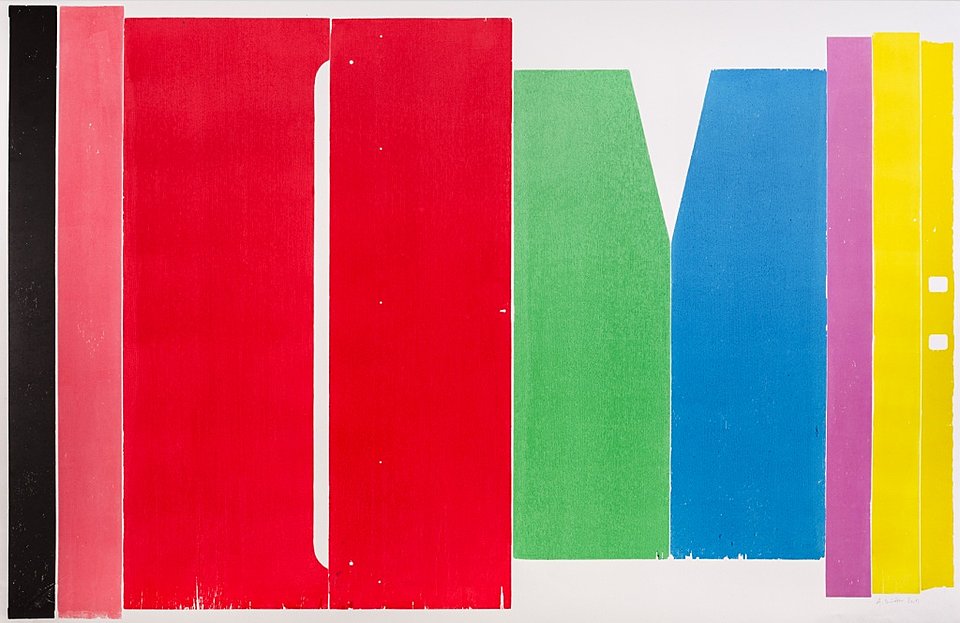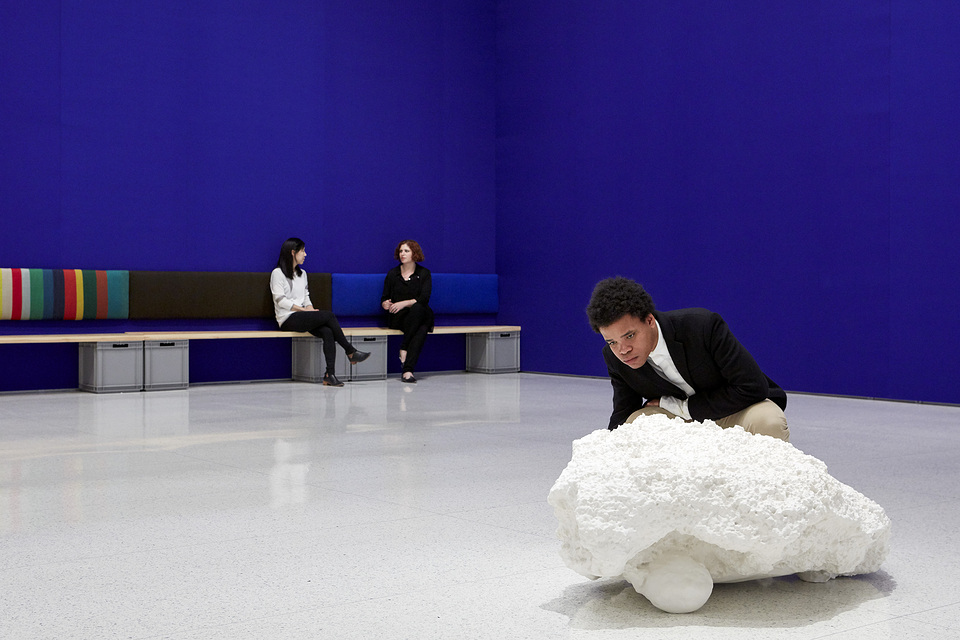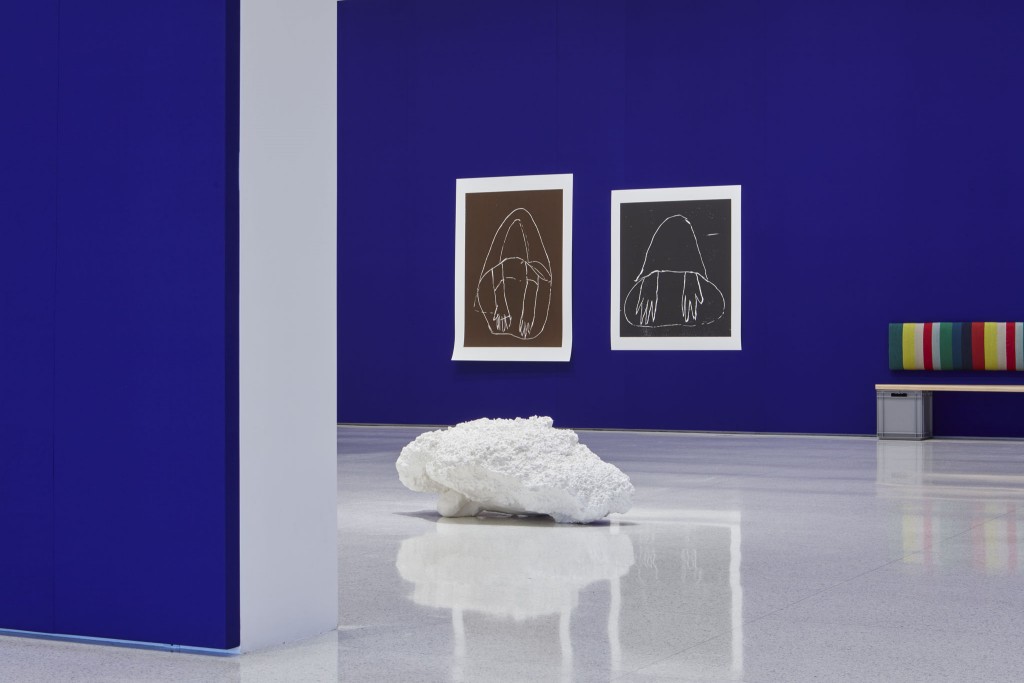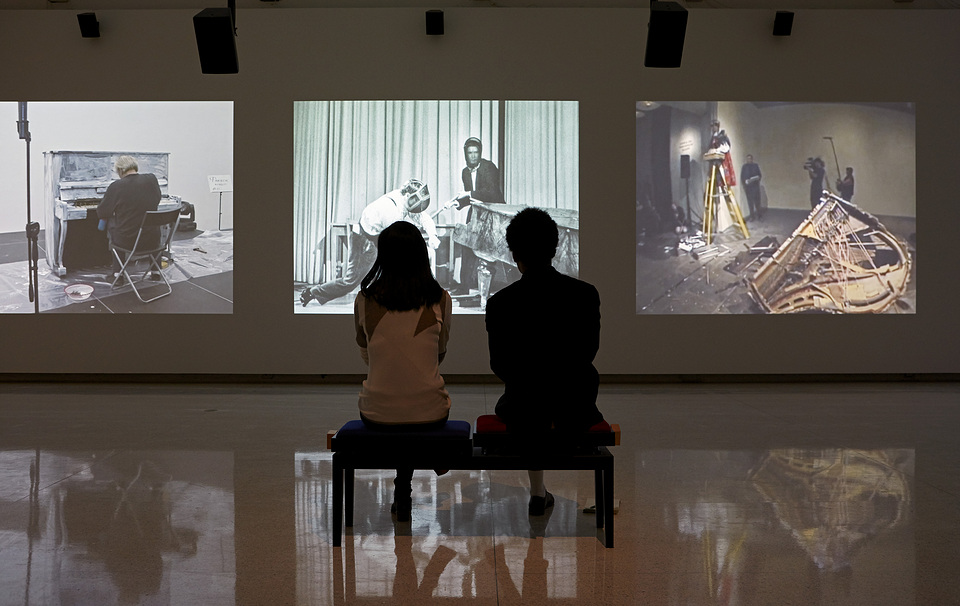Caught in a Bad Romance
Christina Schmid looks into the quiet tension in the corners of Andrea Büttner's work, between humility and humiliation, mistaken identities, dutiful daughters, and weird little sisters.

I never thought of how German or not Andrea Büttner‘s work was until Lars Bang Larsen, in his opening remarks in the gallery, commented on the lack of pretense, the German straightforwardness, in the artist’s work. 1 And while the idea of nationality in relation to her first solo exhibition in the United States resonated with me deeply, the more I thought about the work’s putative directness the less I agreed with Bang Larsen. Here’s why.
Born in 1972, Büttner grew up in a culture possibly unique for its pronounced anti-nationalist sentiment.2 German punk legend Blixa Bargeld, in an interview published in 1993, nails the generational zeitgeist: “The German culture is gone. We hate our culture and our language. All our philosophy and music was appropriated by the Nazis. … We cannot redeem that tradition. We can only reinvent.” The urgency to disavow and dissociate from anything remotely associated with German tradition led to alternative genealogies.3 Renowned German filmmaker Wim Wenders remembers that rock music “was for me the only alternative to Beethoven. … because I was very insecure then about all culture offered to me, because I thought it was all fascism, pure fascism.”4 In the1990s, German-American Euro trash girl band Chicks on Speed sang, “Sometimes they say I’m vermin because my parents, they are German.”5 The insecurity symptomatic of 20th-century German post-war culture gives way to disgust in lyrics that capture an intimacy with experiencing shame and guilt. But while “guilt can be undone with reparations,” as Büttner said in conversation on opening day, “shame can’t.”
In a sense, shame results from a case of mistaken identity: actions are mistaken for agents. What you did becomes conflated with who you are. If guilt arises from regrettable, perhaps unforgivable, actions, committed against better judgment, shame is less predictable. Even in the absence of guilt and judgment, it thrives: hidden, internal, ontic, existential. Shame refutes reason. Büttner wrote her dissertation on shame.
In Andrea Büttner, the title of her exhibition that just so happens to name the work for the artist, she engages German intellectual and art history explicitly: in addition to Ernst Barlach’s sculpture, HAP Grieshaber’s woodcuts, and Robert Schumann’s music, Immanuel Kant’s Critique of the Power of Judgment features prominently. In the margins of the text, Büttner marked each instance when the famous philosopher relied on a verbal description of an image to further his argument. In her version of his book (2014), she provides actual illustrations that match Kant’s words: an exercise that is part homage to the father of formalism, part speculative study of Kant’s library and the images he would likely have had access to in the years prior to 1790, when Critique of Judgment was first published. (The text followed Critique of Pure Reason, 1781, and Critique of Practical Reason, 1788).
The images do more than pay tribute, though: in the dialogue between word and image, a tension between devotion to and subversion of the text unfolds. While Kant argued for the universality and autonomy of beauty from moral sentiment, Büttner’s illustrations follow highly idiosyncratic associations. A mention of a beautiful dress, she explains in her gallery talk, is eventually translated into a photograph of French director Agnes Varda in a dress that’s shaped like a potato. Beauty, perhaps, is not quite so universal after all. Ethics may have to do something with which ideals and standards of beauty we choose to embrace. For Kant, choice was beside the point: when confronted with beauty, we cannot help ourselves. Like shame, beauty resists reason. But does it? When beauty made its comeback to philosophy in the 1990s, Marcia Eaton analyzed how Kant’s ideas have fared under feminist and postcolonial scrutiny. Curiously, a case of mistaken identity lies at the heart of the matter: Kant, writes Eaton, mistook one kind of experience with beauty — the overwhelming, inadvertent, immediate type — for all experiences with beauty.6

Büttner does not join the fray of philosophical argument overtly. Under the covers, though, seriousness meets subterfuge. Her book may look just like one of German publisher Felix Meiner’s standard green hardcover editions of philosophical texts, but a shy, sly irreverence hides in the allusions, private jokes, and pictorial choices gleaned from the 21st rather than the 18th century.
The tension between what we see and what is there in the object, between phenomenon and thing, preoccupied Kant more than two centuries ago. Appearances have not become any less misleading in the meantime. But the consequences of mistaking the appearance for the object have amplified: when the properties of an object exceed human perception—too vast, too slow, too fast, too small, too complex—do we convince ourselves they are not there to begin with, or do we recognize what eludes our grasp? In recent years, the Kantian gap between phenomenon and thing has resurfaced in object-oriented ontology. From global warming to nuclear waste, objects whose proportions put our imaginations to the test surround us. Büttner’s illustrations of the images Kant drew in so many words occasionally hint at such urgency: volcanic eruptions, landslides, storm tossed seas, melting glaciers, a tornado, and signs protesting fracking point to both human hubris and forces far beyond human control.
The artist’s work plumbs the space between appearance and object. While it may be the case that “all objects are hidden from access in some sense,”7 Büttner explicitly engages what is overlooked, veiled, and withheld. Her three Phone Etchings (all 2015) enlarge the smears fingers leave on smartphone screens. She calls them “invisible paintings.” Though produced each day by countless digits, they typically go unnoticed. The etchings document searches, mundane quests for information, that present a digital counterpoint to the laborious mining for meaning Kant performed. Like Images in Kant’s Critique of the Power of Judgment, they participate in an “Epistemology of the Search:” a shift in art away from “a private pursuit leading to significance and profitable discoveries of how images may carry new content … to the formatting and reformatting of existing content.”8 Here, the screen as a window we rely on to interact with the virtual world becomes more than a means-to-an-end and is re-formatted into a distinct material presence.
Corners, too, interest Büttner. Avoided by artists, overlooked by audiences, they harbor a curious cultural history. In traditional German households, benches cradled corners where crucifixes hung. When Malevich displayed his monochrome paintings, he initially chose a corner to reference the traditional space reserved for spiritual reverence.9 In the gallery. Büttner activates a corner with walls wrapped in deep blue cotton twill, a color rich in connotations: from Mary’s robe in countless paintings of art historical importance to tough, work-wear coveralls. Her Benches (2012) similarly combine materials that bridge the refined and the makeshift: hand-woven silk backrests manufactured in a Benedictine abbey sit on a bench supported by plastic stacking crates. Paradox lives in corners: devotion meets abjection. Corners, says Büttner, are a space of shame. To publicly perform contrition, you are to stand in the corner, the space designated to experience humiliation. Shame may be internal, but standing in a corner is meant to make it visible.

Installation view of Andrea Büttner, 2015. Photo: Gene Pittman for the Walker Art Center 
Installation view of Andrea Büttner with two woodcuts, both titled Beggar (2015), in the background. Photo: Gene Pittman
From overlooked architectural features, Andrea Büttner directs us to look down at botanical creatures that have suffered a similar fate: mosses. On low, pale pink tables, Littleness, Cryptogams, Lower Plants (2015) offers three paragraphs by Ray Tangney concerning the diminutive size, clandestine procreative habits, and scientific categorization of mosses. To read, you have to lean forward, bend down a bit — not unlike when looking at the actual plants, on display in Limestone with moss (2015), and Moss (2014), a gypsum sculpture based on the sponge-like growth pattern of a moss. The choreography of bodies moving through the gallery, bending down, humbling themselves to see the work, is mirrored in the poses captured in the Stereoscopic slide show from the Whitehouse collection (2014): photographs of mosses alternate with those of people looking at them, of bodies caught in the strange devotional gestures of keen naturalists. Humiliation and humility share an etymological root: humus, dirt.
Mosses are cryptogamous, like nuns, Büttner points out. The fabric walls’ shade of blue references the distinctive robes worn by The Little Sisters of Jesus, an order the artist speaks of with affection. Taking vows of chastity and poverty, the nuns abstain and withhold, thus choosing a kind of invisibility that honors an inner space of devotion and dedication, an interiority enabled by their economic and sexual decisions. Freedom from possessions may be liberating for them; not so for Büttner’s two Beggars (2015), large-scale woodcuts inspired by Barlach’s sculptures of robed beggars. Her woodcuts offer minimal renderings of expressive gestures: under lines suggesting Barlach’s hooded forms, hands point downward, palms turned upward. Abject, cast out from the social body, beggars cannot afford pride. Their shame is writ large in their hiding. Beg they must but visibility is too much to bear.
Shame acts as verb, too. Stigmatized as less than human, the beggar is a reminder of a fate that could befall us all. Büttner’s Beggars thus embody a fear too great to face. Shame, though a deeply felt private affect, points to the ways “subjectivity [is] laced with structural causality.”10 Shame may refute reason, but even a quick glance at history reveals that shaming has served ideological causes: shaming the poor in a system set up to capitalize on people’s labor masks structural injustices. Similarly political maneuvers are at stake whenever nationality, gender, sexuality, race, size, ability, class–and the list goes on — are harnessed to shame people. Yet what is known does not necessarily reach down to where shame festers unseen. Still, such insight shows that “affective atmospheres are shared, not solitary.”11 For Büttner, though, shame cannot be communicated, only felt on a personal level. Shame is not cultural, she insists.12
This is where we part ways.
The romance with interiority, an “incommunicado core of self,”13 dates back to the Romantic period. Hegel theorized the Romantic as the stage of art when the awareness of the depth of our inner lives, the ability to reflect on our interiority — qualities he combines into ‘Spirit’ — far outstripped the means and materials of charting, expressing, and representing this vast inner space.14 As a result, “it becomes radically impossible to embody this inner space in any nonhuman entity.”15 Faced with impossibility, artists still try, tragically, heroically, to traverse and hint at this profound, incommunicable interiority. Art becomes a story of inevitable, sublime failure. The piano played a prominent part in this doomed quest: “a Romantic hero,”16 it features in Büttner’s five-channel video installation, titled Piano Destructions (2014).
Luscious arpeggios and ritardandos spill from the Walker’s Medtronic Gallery and float through the white staircase. On one screen, nine women play black grand pianos, their music projected by nine speakers, one for each pianist. Büttner chose scores by Robert Schumann, Frederic Chopin, and commissioned an arrangement for piano of two choir pieces by Monteverdi. On the four other screens, set apart on a separate wall, mostly (though not exclusively) male artists attack pianos by every means imaginable: dropped from great heights, set aflame, submerged, attacked with saws, drills, nails, and sledge hammers, the hapless instruments suffer spectacular torture. Based on the artist’s research in the Center’s archives, the thirty-some documentaries turn destruction into a spectacle medieval in its symbolic cruelty. When the lovely music ends, the cacophony of destruction takes over.

At first glance Piano Destructions offers a stark, unsubtly gendered contrast. Women cooperate to produce beautiful sounds; men, mostly single-handedly, act with aggression to destroy the source of sound. Some of the artists performed their destructions in Germany, in Wiesbaden, Cologne, Gelsenkirchen, and Wuppertal. Some, like George Maciunas, had left Europe in the wake of another, much greater destruction: the Third Reich, the Holocaust. All were eager to attack the piano as the symbol of a compliant, complicit gentile bourgeoisie and the role it played in the genocide of European Jews. Propriety comes at a terrible price. Not speaking up has consequences, then and now. Thus, the piano served as the epitome of bourgeois pretensions: its cost, size, and maintenance reserved the instrument for those with the means necessary for housing, tuning, and learning to play it. It stood for a culture of acquiescence, the shelter of lovely parlors where the dutiful daughters of the bourgeoisie exercised their agile fingers on etudes and sonatas; its wooden body, cradling a metal skeleton taut with strings, a convenient metonymy for all the post-war avant garde wanted to break with. But its curves and the intimate, disciplined contact the piano demands of its players are so very reminiscent of other bodies that, once touched in the right way, quiver — just like strings vibrate when caressed by felt-covered hammers.
Like good lovers, pianists are perfectly attuned to the bodies they interact with: the weight of the keys, their response and pick up, the touch and release of a pedal. If elsewhere in Andrea Büttner the body is veiled, present only in traces and smears, its sensuality masked with moss and philosophy, here discipline and skill imperfectly disguise the pleasure of being immersed in the music they make together. Büttner’s video of their performance captures the intimacy of their interactions: bare shoulders and graceful wrists rise and fall with the music. Paired with fierce concentration, theirs is a restrained sensuality that steers clear of sentimentality, that supposed excess of emotion women have been accused of too often. Ever so subtly, the players sway. And somewhere between maintaining the appearance of good daughters at stately pianos, invisible imaginations take flight. (In German, the grand piano is called Flügel, “wing.”)
Shame may appear as an exclusively private affect but it leaves undeniable traces, smears, in bodies and cultures, in furtive gestures of submission and assertions of dominance, in the very way bodies occupy spaces: with a sense of entitlement, reluctance, and the anticipation of being put into their place.
Despite their intimate knowledge of the pianos’ massive, tender bodies, their technical prowess and profound feeling for the music, the pianists’ performances would have been dismissed as lacking the foundational tenets of true art: void of original expression, they amounted to nothing more than derivative ventriloquy. The standards of judging what should and should not count as art were subject for much debate in the 18th century. Kant’s was one of the prominent voices in the arguments that eventually elevated a certain set of activities to the domain of fine art and relegated others to the inconsequential. Not surprisingly, many of these cultural demarcations followed lines drawn by the politics of gender, race, and class. Women’s contributions were routinely overlooked, their achievements belittled. Their history aligns with Büttner’s interests: small cryptogamous mosses, overlooked corners, a dance of humility and humiliation.
Once again, Büttner relies on a quiet tactic: rather than arguing straightforwardly on behalf of the belittled and overlooked, her work settles into the space of faux invisibility. Inconspicuous, the strategy is reminiscent of revolutionary practices Maurizio Lazzarato associates with Workerism: “social struggles and ‘invisible’ behaviors engage in both direct, molar confrontations with the apparatuses of power and strategies of withdrawal, flight and circumvention.”17 Here, quotation marks frame what is ‘invisible’ as entirely dependent on who is looking from which point of view to be able to see — well, what, exactly. Invisibility is harnessed as a shared strategy of a resistance that cannot at times risk being loud and explicit.
The risk Büttner’s romance with interiority runs does not only lie in its degree of visibility. Risking invisibility can mean both clandestine power — to see but not be seen, to act under the radar — and not-so-secret pain: the hurt caused by being erased, rejected, and unseen. Shared, pain may allow for solidarity, for sisterhood. ‘Invisible’ behaviors still harbor potential agency — withdrawal, flight, circumvention. Insisting on the inviolable and incommunicable privacy of an inner space, though, risks a toxic romance with shame. Suffered in isolation and severed from the very possibility of speaking its name, shame curbs agency. In developmental psychology, an organism, when judged to the point of rejection, will internalize the perceived reasons for such judgment and make them its own in order to claim at least some semblance of agency. Absorbing judgment that confuses action with identity allows shame to bloom in secret but does not stifle the desire to please. In Büttner’s Flying Man (2015), a woodcut based on Marc Chagall’s 1915 painting, the shape of an armless man floats across a white void. Incapacitated without limbs to reach for a lover, he twists his neck for a kiss. Forlorn, alone, the Flying Man, like any artist, risks rejection, exquisite in the vulnerability of anticipating judgment. His sensuality is permissible only under the sign of restraint, not unlike the discipline that reigns over the pianists’ performance.
One question lingers in the aftermath of encountering Andrea Büttner: when do we move beyond being dutiful daughters — a model that has served the artist well — and into a post-Romantic age? When is it time to abandon the bad romance with solitary shameful suffering and to embrace a subjectivity that recognizes it is indeed laced with structural causality? Shame may appear as an exclusively private affect but it leaves undeniable traces, smears, in bodies and cultures, in furtive gestures of submission and assertions of dominance, in the very way bodies occupy spaces: with a sense of entitlement, reluctance, and the anticipation of being put into their place. The body keeps the score, in its stillness and its sway; in the way withholding may double as an elegant tease whose mystery does not survive the final denouement. But what if dutiful daughters dared imagine entirely different behaviors of the “fussy and undignified” sort? What if, rather than fetishizing shame into a heroic inner battle with specters of judgment, the weird little sisters of masculinist philosophizing and art-making embraced embarrassing behavior instead?
In Women Who Make a Fuss, Isabelle Stengers and Vinciane Despret end their deliberations with a story from the late 19th century, when “Louis Deibler, the chief executioner, asked the President of the Republic to automatically grant clemency to women, these spoilers of his profession.”18 Lacking the dignity to walk to the guillotine all stoic-heroic and self-possessed, women peed and screamed and cried, with unpredictable, undignified results. Rather than retreat to solitary interiority in elegant restraint, they changed history by being unapologetically embarrassing.
Related exhibition information: Andrea Buttner is on view at the Walker Art Center in Minneapolis through April 10, 2016.